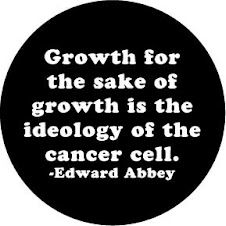I've discussed the threats from modern industrial agriculture to one of our most valuable resources, our soil, in past posts.
Here are a few stats from my
Soil Erosion post back in February of this year.
* The United States is losing soil 10 times faster -- and China and India are losing soil 30 to 40 times faster -- than the natural replenishment rate.
* The economic impact of soil erosion in the United States costs the nation about $37.6 billion each year in productivity losses. Damage from soil erosion worldwide is estimated to be $400 billion per year.
* As a result of erosion over the past 40 years, 30 percent of the world's arable land has become unproductive.
(http://www.news.cornell.edu/stories/March06/soil.erosion.threat.ssl.html Feb 2008)
This is the type of vital ecosystem service George Monbiot discusses in the article I linked to in my recent post,
Externalities?Now I'd like to discuss some of the benefits of proper maintenance of that precious resource, our soil, through organic agriculture.
Rodale Institute has published some research cataloging the potential effects proper soil husbandry can have on global warming. Much of the information and graphics for this post is drawn from the report.
Aside from the obvious benefits of growing food, providing a base for vegetation that prevents erosion, acting as a sponge to mitigate the effects of flooding, reducing pollution from agricultural runoff, the soil offers other less well known services. If treated properly soil sequesters carbon, it actually locks up more carbon than the vegetation growing on it.
"On a global scale, soils hold more than twice as much carbon (an estimated 1.74 trillion US tons) as does terrestrial vegetation (672 trillion US tons)."
This is accomplished through the buildup of humic substances, soil organic matter or SOM, in the soil that allow long term carbon storage. This SOM, which is primarily made up of carbon, is the heart and soul of organic agriculture. SOM is almost completely avoided in industrial agriculture which uses petrochemicals to replace the nutrients otherwise provided.
The naturally developed grassland soils that much of the American corn and soy crop grows in was originally comprised of 6-10% SOM. These soils have been degraded to typically 1-3% by industrial agricultural methods. Indeed, Rodales research over 27 years indicates that organic systems increased soil carbon by 30% while their similar petrochemically managed fields showed no increase in carbon.
This effect is largely down to a beneficial environment for fungi which is fostered by organic methods. No only does fungi assist in the processes necessary for carbon sequestration but,
"Mycorrhizal fungi structures enhance the ability of plant roots to access soil moisture and nutrients, produce stable compounds to sequester carbon dioxide as soil carbon, and slow decay of soil organic compounds."
Fungi is most amazing stuff. For more on that check out the work by Paul Stamets at
Fungi.com.
Additionally the practices of organic fertilization and cropping diversity stimulates carbon sequestration whereas petroleum based practices and mono cropping stimulates quick decay of SOM thus releasing carbon into the atmosphere.
Organic practices like cover crops and composting have direct benefits to the atmosphere in that they use 33% less fossil fuel in the farming practices themselves compared to petroleum fertilizer based practices. Further Rodale research has shown that,
"the use of composted manure with crop rotation in organic systems can result in carbon sequestration of up to 2000 lbs/ac/yr. By contrast, fields under standard tillage relying on chemical fertilizers lost almost 300 pounds of carbon per acre per year."
If all 43 million acres of cropland in the US were to use these methods 1.6 billion tons/yr would be sequestered, around 25% of the total US fossil fuel emissions.
Here are some more facts about Organic agriculture from the
Organic Consumers Association,
- If organic farming methods were practiced on all the planet's food-growing land, it would be like taking more than 1.5 billion cars off the road.
- You can increase your antioxidant intake by 30 percent by choosing organic.
- The average child in America is exposed to five pesticides daily in their food and drinking water.
- The U.S. water system is regularly contaminated above safe limits immediately following chemical fertilizer applications to farm fields.
- Farms in developing countries that use organic techniques produce an average of 79% more than farms that don't.
So it seems clear that organic agriculture produces healthier food, more food, is far less damaging to the soil and surrounding ecosystem, and can help mitigate global warming and climate change. It looks like the sustainable choice to me.
Thanks to Rodale Institute for the report from which most of this post is drawn and the Organic Consumers Association for pointing me in that direction and for additional facts.



















.jpg)






